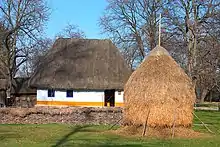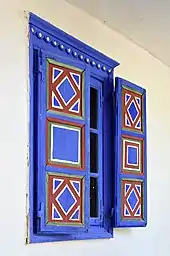Muzeul Național al Satului "Dimitrie Gusti" | |
_Biserica_de_lemn_din_Dragomire%C8%99ti%252C_Maramure%C8%99%252C_1722_-_img_18.jpg.webp) | |
| Established | 1936 |
|---|---|
| Location | King Michael I Park, Bucharest, Romania |
| Coordinates | 44°28′24″N 26°04′36″E / 44.47336°N 26.07656°E |
| Type | open-air ethnographic museum |
| Collection size | 123 settlements, 363 monuments, over 50,000 artefacts |
| Founder | Dimitrie Gusti |
| Website | www |
The Village Museum or formally National Museum of the Village "Dimitrie Gusti" (Romanian: Muzeul Național al Satului "Dimitrie Gusti") is an open-air ethnographic museum located in the King Michael I Park, Bucharest, Romania. The museum showcases traditional Romanian village life. The museum extends to over 100,000 m2,[1] and contains 123 authentic peasant settlements, 363 monuments and over 50,000 artefacts from around Romania.[2] Structures in the museum ranged from the 17th to the 20th century, representative of different ethnographic regions including Banat, Transylvania, Moldavia, Maramures, Oltenia, Dobrogea, Muntenia.[2]
The village was a creation of the folklorist and sociologist Dimitrie Gusti. The location plans were executed by the writer, playwright, director Victor Ion Popa and set designer Henri H. Stahl. The necessary financial funds were provided by the Royal Cultural Foundation and in the presence of King Carol II of Romania the museum was inaugurated on 10 May 1936.[3] At the time of its inauguration, it was the fourth open-air museum of Europe after Skansen (Stockholm, Sweden), Norsk Folkemuseum at Bygdøy (Oslo, Norway), and the Ethnographic Museum of Transylvania at Hoia Forest in Cluj-Napoca.[3] The museum initially was 4.5 ha in size with 33 authentic settlements that were transferred from the researched villages. Among them was the Maramures wooden church from Dragomirești, Maramures county.[3] The building remains the central piece and is incorporated into the logo of the museum.
Gallery
 18th century Suceava County house
18th century Suceava County house 18th century Neamț County church
18th century Neamț County church 19th century Suceava County house
19th century Suceava County house 19th century Neamț County house
19th century Neamț County house 19th century Neamț County house
19th century Neamț County house 19th century Maramureș house
19th century Maramureș house 19th century Timiș County house
19th century Timiș County house Tulcea County fishery
Tulcea County fishery Inn
Inn Mill
Mill 19th century Olt County mud hut
19th century Olt County mud hut 18th century Maramureș church
18th century Maramureș church 19th century Alba County house
19th century Alba County house 19th century Brașov County house
19th century Brașov County house 19th century Alba County house
19th century Alba County house 19th century Alba County house
19th century Alba County house Shrine
Shrine Well
Well Gate
Gate Pigeonry
Pigeonry Food box
Food box Wine barrel
Wine barrel Oven
Oven Window
Window Summer kitchen
Summer kitchen
See also
References
- ↑ "Village Museum". Civitalis Bucharest. Retrieved 31 October 2023.
- 1 2 "The National Museum of the Village "Dimitrie Gusti"". Visit Bucharest. Retrieved 31 October 2023.
- 1 2 3 "HISTORICAL BRIEF OF THE NATIONAL VILLAGE MUSEUM "Dimitrie Gusti"". “DIMTRIE GUSTI” NATIONAL VILLAGE MUSEUM. Retrieved 31 October 2023.